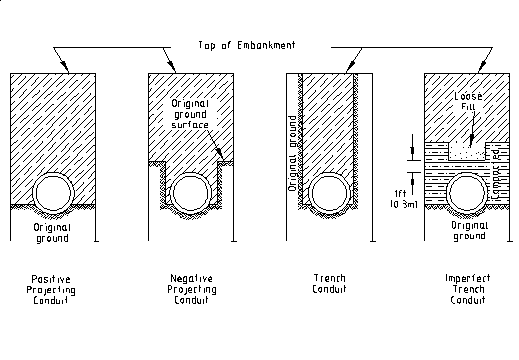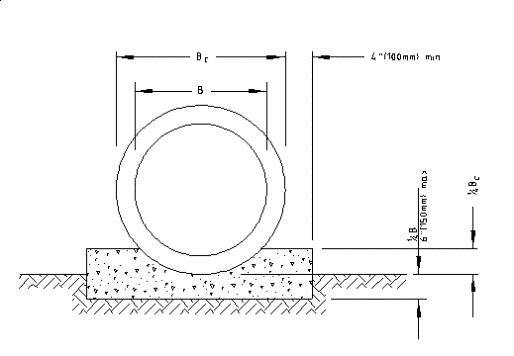Section 3: Installation Conditions
Anchor: #i1006111Introduction
Pipe has four basic installation conditions, as illustrated in Figure 14‑1.
Figure 14-1. Pipe Installation Conditions
Anchor: #i1006133Trench
Trench installation of conduit is most preferred from the standpoint of structural advantage and long term operational costs. In order to establish trench conditions, the minimum trench shapes must conform to the diagrams shown in Figure 14-2.
Figure 14-2. Permissible Trench Shapes
Anchor: #i1006153Positive Projecting (Embankment)
Positive projecting installation, sometimes termed “embankment installation,” is the simplest technique and has the most economical first cost. However, operationally, it does not serve to relieve any structural loading from above the conduit and may result in failure or high maintenance costs during the life of the structure.
Anchor: #i1006163Negative Projecting (Embankment)
Negative projecting conditions are more costly than the positive projecting conditions. Negative projection provides some loading relief from the conduit due to the frictional interface between the trench boundaries and the backfill. See Figure 14-1 for a schematic of this effect. Negative projection conditions normally become cost-effective only when fill heights approach 30 ft. (10 m).
Anchor: #i1006175Imperfect Trench
The imperfect trench condition is usually more costly than any of the other three installation conditions shown. As with negative projection installation, imperfect trench installation normally becomes cost-effective only when fill heights approach 30 ft. (10 m).
Anchor: #i1006185Bedding for Pipe Conduits
In general, bedding for a conduit should comprise select, compact material that conforms to the external curvature of the conduit it supports. This is important for both flexible and rigid conduits.
For a flexible conduit, irregularities or imperfections in the bedding usually can be accommodated by minor shape deformations in the conduit without damage to the structural integrity of the pipe.
For a rigid conduit, such irregularities or imperfections in the bedding cannot be accommodated because the conduit cannot reshape itself without structural failure. Due to the compressive/tensile characteristics of rigid pipe under a load, critical shear zones can fail if bedding geometry is not in conformance with specifications. See Figure 14-3 for a schematic illustration of this characteristic.
Figure 14-3. Critical Shear Stress Zones for Rigid Pipe
Planned bedding should be supported thoroughly by specifications.
Bedding affects required reinforced concrete pipe strength. The four recognized classes of bedding are shown in Figures 14-4 through 14-7. The most common classes of bedding are Class B and Class C. Class C is the most economical and Class A the most expensive. However, for a given fill height, Class A bedding requires the lowest reinforced concrete pipe strength, and Class C requires the greatest strength. Base selection of bedding on designing the most cost-effective facility.
Figure 14-4. Class A Bedding
Figure 14-5. Class B Bedding
Figure 14-6. Class C Bedding
Figure 14-7. Class C Bedding on Rock Foundation


